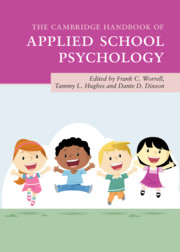Book contents
- The Cambridge Handbook of Applied School Psychology
- The Cambridge Handbook of Applied School Psychology
- Copyright page
- Contents
- Contributors
- Contributor Biographies
- Acknowledgments
- 1 Broadening the Focus of School Psychology Practice
- Part I Individual-Level Academic Interventions
- Part II Teacher- and System-Level Interventions
- Part III Interventions from Educational and Social/Personality Psychology
- Part IV Behavioral and Social-Emotional Interventions
- Part V Health and Pediatric Interventions
- Part VI Family Connections and Life Transitions
- 30 Parent–Teacher Relationships
- 31 The School Psychologist’s Role in Facilitating the Transition to College
- 32 Transition from School to Work within a Theory-based Problem-Solving Framework
- Part VII Special Populations
- Part VIII Conclusion
- Index
- References
31 - The School Psychologist’s Role in Facilitating the Transition to College
from Part VI - Family Connections and Life Transitions
Published online by Cambridge University Press: 18 September 2020
- The Cambridge Handbook of Applied School Psychology
- The Cambridge Handbook of Applied School Psychology
- Copyright page
- Contents
- Contributors
- Contributor Biographies
- Acknowledgments
- 1 Broadening the Focus of School Psychology Practice
- Part I Individual-Level Academic Interventions
- Part II Teacher- and System-Level Interventions
- Part III Interventions from Educational and Social/Personality Psychology
- Part IV Behavioral and Social-Emotional Interventions
- Part V Health and Pediatric Interventions
- Part VI Family Connections and Life Transitions
- 30 Parent–Teacher Relationships
- 31 The School Psychologist’s Role in Facilitating the Transition to College
- 32 Transition from School to Work within a Theory-based Problem-Solving Framework
- Part VII Special Populations
- Part VIII Conclusion
- Index
- References
Summary
More than 67% of current high school completers attend some form of higher education, with the current college population reflecting increased diversity, with greater numbers of first-generation college students and individuals with handicapping conditions. Although transitions are for the most part positive in the emerging adult population, they also bring opportunities and challenges. Identity consolidation, striving for independence, leaving home, self-advocacy, and the ability to engage in prosocial coping become significant issues. The school psychologist can be a vital facilitator in preparing students for this critical transition and building the foundation for successful adulthood for all students, but particularly those with special needs.
Keywords
- Type
- Chapter
- Information
- The Cambridge Handbook of Applied School Psychology , pp. 538 - 552Publisher: Cambridge University PressPrint publication year: 2020



